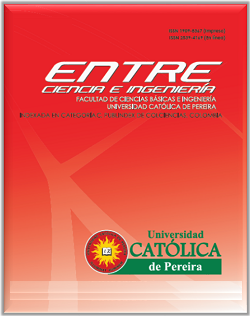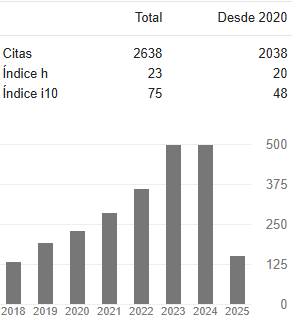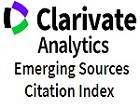Evaluation of a non-domestic wastewater treatment system for the removal of organic cargo in the non-alcoholic beverage industry
DOI:
https://doi.org/10.31908/19098367.1150Keywords:
Non-domestic wastewater (nDWW), organic load, BOD, CODAbstract
The document presented here corresponds to the evaluation of a wastewater treatment system belonging to the manufacturing industry of carbonated and non-carbonated soft drinks. The development of this study was performed through 3 samplings carried out in the months of May, July and October (where the maintenance and cleaning operations of the system were carried out in July with the purpose of observing their implications in October) and 6 different points of the treatment plant were sampled. From the obtained samples, the insitu information was determined, the presence of bionutrients, the physical and chemical characteristics, and the BOD and COD parameters, in order to interpret their performance in terms of removal of contaminating organic load, and establish the control parameters required by the current legal regulations of the country to identify the problems existing in the system, their possible causes and the approach of a recommendation as a theoretical solution to the irregularities observed. It was evidenced that the pretreatment phase has a good performance in the development of treatment activities due to its stability in temperature and pH; however, the generation of residual sludge in this phase comprises a problem that directly impacts on the cost of operation and maintenance of the treatment system. The effluent from the production plant showed that the addition of chemical agents and the generation rate of activated sludge against the aerobic conditions of the system are the greatest support that the plant has to perform the processes of degradation in organic matter. The physicochemical characterization of the wastewater helped determine whether the mechanisms belonging to the treatment train developed their unit operations under efficient conditions for the reduction of organic load. Thanks to what was observed in this study, it would be beneficial for the system to implement complementary structures to the homogenizer tank and equalizer tank, for the reduction in the production of residual sludge, since this problem when being carried from the initial structures of the treatment train entails to the loss of efficiency in the subsequent processes to this throughout the system.
Downloads
References
Plan nacional de manejo de aguas residuales municipales en Colombia ministerio de ambiente, vivienda y desarrollo territorial Bogotá, D.C. junio de 2004.
Z. Vélez. Los Biosólidos: ¿Una solución o un Problema? Producción + Limpia 2 (2), 58-71, 2007.
Q. Wang, W. Wei, Y. Gong, Q. Yu, Q. Li, J. Sun, y Z. Yuan. Technologies for reducing sludge production in wastewater treatment plants: State of the art. Science of the Total Environment Science 587–588, 510–521. Doi: 10.1016/j.scitotenv.2017.02.203, 2017.
M. Alemán. Estudio de Impacto Ambiental EXPOST, Planta Norte Embotelladora de Bebidas El Inca, No. de Proyecto: 1047560, cardno forjando el futuro, Información del Documento, 2016. Preparado para: Bebidas Arcacontinental Ecuador, ARCADOR S.A.
D. Azeredo, V. Alvarenga, A. A. Sant’Ana y A. U. Sabaa. An overview of microorganisms and factors contributing for the microbial stability of carbonated soft drinks. Food Research International 82, 136-144. doi: 10.1016/j.foodres.2016.01.024, 2016.
Q. Zhang, J. Hu, D. Lee, Y. Chang, y Y. Lee. Sludge treatment: Current research trends. Bioresource Technology 243, 1159-1172. doi: 10.1016/j.scitotenv.2017.02.203, 2017.
J. A. Romero. Tratamiento de Aguas Residuales. Teoría y Diseño, Bogotá Colombia, Escuela Colombiana de Ingeniería, 2000.
Y. Pan, H. Li, X. Zhang, y A. Li. Characterization of natural organic matter in drinking water: Sample preparation and analytical approaches. Trends in Environmental Analytical Chemistry, 12, 23-30. doi: 10.1016/j.teac.2016.11.002, 2016.
J. A. Rodríguez. Tratamiento anaerobio de aguas residuales. Universidad Del Valle. Cali, Colombia. Recuperado de www.ingenieroambiental.com › tratamiento545.
S. S. Marshall, y G. E. Innocentia. Multi-stage EGSB/MBR treatment of soft drink industry wastewater. Chemical Engineering Journal 285, 368–377 doi: 10.1016/j.cej.2015.10.021, 2015.
G. Cuff, A. E. Turcios, E. M. Pajooh, Kujawski, D. Weichgrebe, Rosewinkel. High-rate anaerobic treatment of wastewater from soft drink industry: Methods, performance and experiences. Journal of Environmental Management 220, 8-15. doi: 10.1016/j.jenvman.2018.05.015, 2018.
S. V. Jadhav, S. S. Haramkar, A. R. Kamble, y B. N. Thorat. Insights into dewatering and characterization of the waste activated sludge. Journal of the Taiwan Institute of Chemical Engineers 000, 1–7. doi: 10.1016/j.jtice.2017.11.035, 2017.
J. L. Zou, G. R. Xu, K. Pan, W. Zhou, W. Dai, Xue., Zhang, Di., Y. C. Hu, y M. Ma. Nitrogen removal and biofilm structure affected by COD/NH4+–N in a biofilter with porous sludge-ceramsite doi: 10.1016/j.seppur.2012.03.019, 2012.
M. A. Latif, C. M. Mehta, y D. J. Batstone. Low pH anaerobic digestion of waste activated sludge for enhanced phosphorous release. Water Research 81 (2015) 288-293, 2015.
J. V. Arboleda. Teoría y práctica de la purificación del agua, Bogotá Colombia, Acodal. Asociación Colombiana de Ingeniería Sanitaria y Ambiental, 1992.
Y. Wen, Y. Mao, y X. Wang. Application of chromaticity coordinates for solution turbidity measurement. Measurement 130 (2018) 39–43 doi: 10.1016/j.measurement.2018.07.0817, 2018.
Instituto de Hidrología, Meteorología y Estudios Ambientales Ministerio de Ambiente, Vivienda y Desarrollo Territorial – República de Colombia.
Downloads
Published
Issue
Section
License
Copyright (c) 2025 Entre ciencia e ingeniería

This work is licensed under a Creative Commons Attribution-NonCommercial 4.0 International License.



















